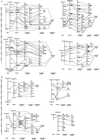Comparative mapping of Andropogoneae: Saccharum L. (sugarcane) and its relation to sorghum and maize
- PMID: 9405600
- PMCID: PMC24932
- DOI: 10.1073/pnas.94.26.14261
Comparative mapping of Andropogoneae: Saccharum L. (sugarcane) and its relation to sorghum and maize
Abstract
Comparative genetic maps of Papuan Saccharum officinarum L. (2n = 80) and S. robustum (2n = 80) were constructed by using single-dose DNA markers (SDMs). SDM-framework maps of S. officinarum and S. robustum were compared with genetic maps of sorghum and maize by way of anchor restriction fragment length polymorphism probes. The resulting comparisons showed striking colinearity between the sorghum and Saccharum genomes. There were no differences in marker order between S. officinarum and sorghum. Furthermore, there were no alterations in SDM order between S. officinarum and S. robustum. The S. officinarum and S. robustum maps also were compared with the map of the polysomic octoploid S. spontaneum 'SES 208' (2n = 64, x = 8), thus permitting relations to homology groups ("chromosomes") of S. spontaneum to be studied. Investigation of transmission genetics in S. officinarum and S. robustum confirmed preliminary results that showed incomplete polysomy in these species. Because of incomplete polysomy, multiple-dose markers could not be mapped for lack of a genetic model for their segregation. To coalesce S. officinarum and S. robustum linkage groups into homology groups (composed of homologous pairing partners), they were compared with sorghum (2n = 20), which functioned as a synthetic diploid. Groupings suggested by comparative mapping were found to be highly concordant with groupings based on highly polymorphic restriction fragment length polymorphism probes detecting multiple SDMs. The resulting comparative maps serve as bridges to allow information from one Andropogoneae to be used by another, for breeding, ecology, evolution, and molecular biology.
Figures

References
-
- Clayton W D, Renvoize S A. Genera Graminum: Grasses of the World, Kew Bulletin Additional Series XIII. London: Her Majesty’s Stationary Office; 1986.
-
- daSilva J, Sobral B W S. In: The Impact of Plant Molecular Genetics. Sobral B W S, editor. Boston: Birkhäuser; 1996. pp. 3–37.
-
- daSilva J, Sorrells M E, Burnquist W L, Tanksley S D. Genome. 1993;36:782–791. - PubMed
-
- daSilva J, Honeycutt R J, Burnquist W L, Al-Janabi S M, Sorrells M E, Tanksley S D, Sobral B W S. Mol Breed. 1995;1:165–179.
LinkOut - more resources
Full Text Sources

